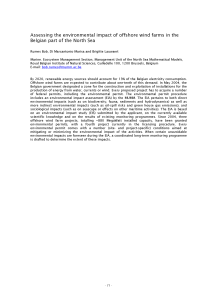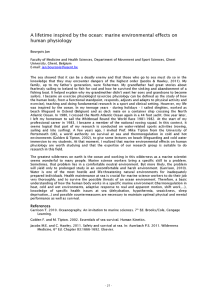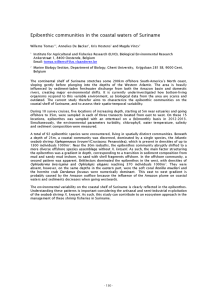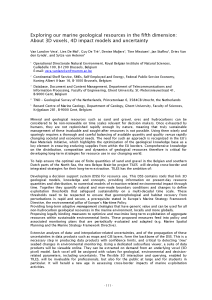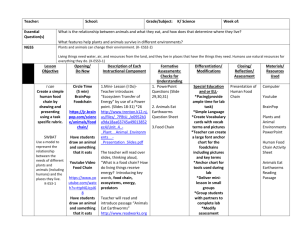Parental feeding behaviour, m ercury accum... (Larus fuscus)
advertisement
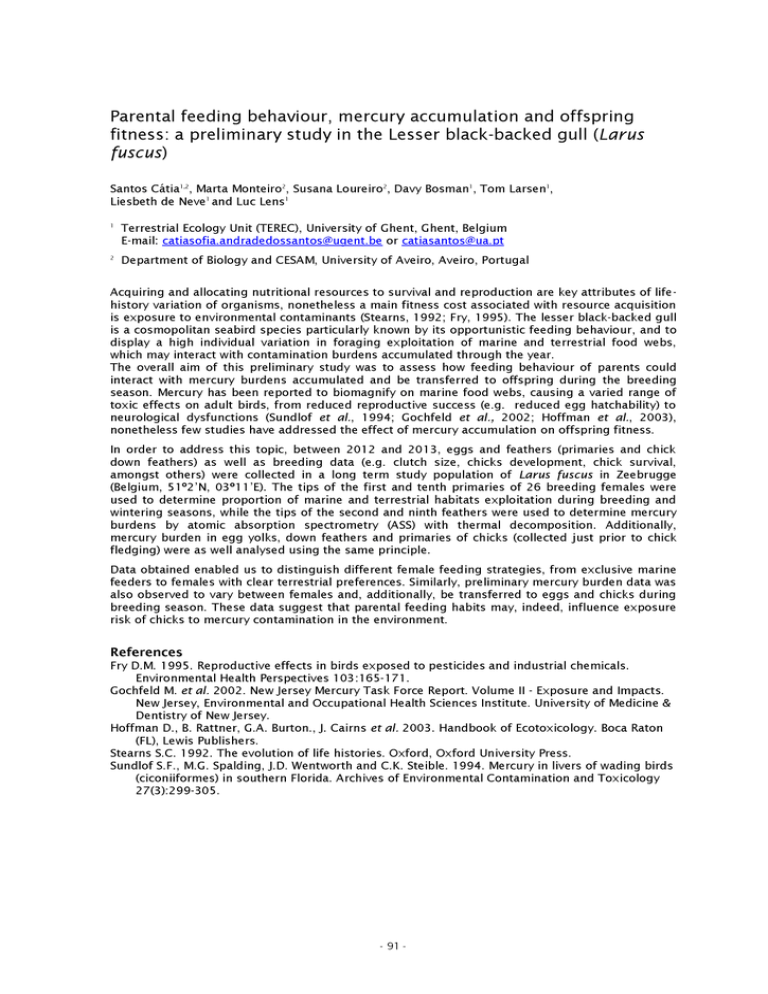
Parental feeding behaviour, m ercury accum ulation and o ffs p rin g fitness: a p re lim ina ry study in the Lesser black-backed guii (Larus fuscus) Santos Cátia12, Marta M onteiro2, Susana Loureiro2, Davy Bosman', Tom Larsen1, Liesbeth de Neve1and Luc Lens' 1 T errestrial Ecology Unit (TEREC), U niversity o f Ghent, Ghent, Belgium E-mail: catiasofia.andradedossantos@ uqent.be or catiasantos@ ua.pt 2 D epartm ent o f Biology and CESAM, U niversity o f Aveiro, Aveiro, Portugal A cquiring and allocating n u tritio n a l resources to survival and reproduction are key a ttrib u te s o f life history variation o f organism s, nonetheless a main fitness cost associated w ith resource acquisition is exposure to environm ental contam inants (Stearns, 1992; Fry, 1995). The lesser black-backed guii is a cosm opolitan seabird species particula rly known by its o p p o rtu n is tic feeding behaviour, and to display a high individual variation in foraging e x p lo ita tio n o f marine and te rre stria l food webs, which may interact w ith contam ination burdens accum ulated th ro u g h the year. The overall aim o f th is prelim inary study was to assess how feeding behaviour o f parents could interact w ith m ercury burdens accum ulated and be transferred to o ffsp rin g during the breeding season. Mercury has been reported to bio m a g nify on marine food webs, causing a varied range o f to xic effects on a du lt birds, fro m reduced reproductive success (e.g. reduced egg hatchability) to neurological dysfunctions (Sundlof e t a i, 1994; Gochfeld e t a i, 2002; Hoffm an e t a i, 2003), nonetheless few studies have addressed the effect o f m ercury accum ulation on o ffsp rin g fitness. In ord er to address th is topic, between 2012 and 2013, eggs and feathers (prim aries and chick down feathers) as well as breeding data (e.g. clutch size, chicks developm ent, chick survival, am ongst others) were collected in a long term study population o f ia r u s fuscus in Zeebrugge (Belgium, 5 1 °2 ’ N, 0 3 °1 1 ’E). The tip s o f the firs t and tenth prim aries o f 26 breeding fem ales were used to determ ine pro po rtio n o f marine and te rre stria l habitats e x p lo ita tio n during breeding and w inte rin g seasons, while the tip s o f the second and ninth feathers were used to determ ine m ercury burdens by atom ic absorption spectrom etry (ASS) w ith therm al decom position. A d ditio na lly, m ercury burden in egg yolks, down feathers and prim aries o f chicks (collected ju s t p rio r to chick fle dg in g) were as well analysed using the same principle. Data obtained enabled us to d istin gu ish d iffe re n t female feeding strategies, from exclusive marine feeders to females w ith clear te rre stria l preferences. Sim ilarly, pre lim ina ry m ercury burden data was also observed to vary between females and, additionally, be transferred to eggs and chicks during breeding season. These data suggest th a t parental feeding habits may, indeed, influence exposure risk o f chicks to m ercury contam ination in the environm ent. References Fry D.M. 1995. Reproductive effects in birds exposed to pesticides and industrial chemicals. Environm ental Health Perspectives 103:165-171. Gochfeld M. e t a i 2002. New Jersey M ercury Task Force Report. Volum e II - Exposure and Impacts. New Jersey, Environm ental and O ccupational Health Sciences Institute. U niversity o f Medicine & D entistry o f New Jersey. Hoffman D., B. Rattner, G.A. Burton., J. Cairns et a i 2003. H andbook o f Ecotoxicology. Boca Raton (FL), Lewis Publishers. Stearns S.C. 1992. The evolution o f life histories. O xford, O xford U niversity Press. Sundlof S.F., M.G. Spalding, J.D. W entw orth and C.K. Steible. 1994. M ercury in livers o f w ading birds (ciconiiform es) in southern Florida. Archives o f Environm ental C ontam ination and T oxico lo g y 27(3):299-305. - 91 -
